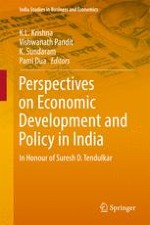2017 | OriginalPaper | Chapter
9. Determinants of Import Intensity of India’s Manufactured Exports Under the New Policy Regime
Author : Bishwanath Goldar
Published in: Perspectives on Economic Development and Policy in India
Publisher: Springer Singapore
Activate our intelligent search to find suitable subject content or patents.
Select sections of text to find matching patents with Artificial Intelligence. powered by
Select sections of text to find additional relevant content using AI-assisted search. powered by
